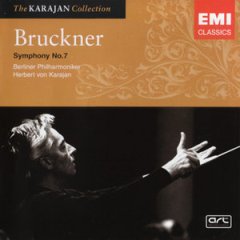Anton Bruckner - Symphony No. 7 in E major (Karajan) [1971]
Anton Bruckner - Symphony No. 7 in E major (Karajan) [1971]

1. Allegro moderato 2. Adagio (Sehr feierlich und sehr langsam) 3. Scherzo (Sehr schnell) & Trio (Etwaslangsamer) 4. Finale (Bewegt, doch nicht schnell) Berliner Philharmoniker Herbert von Karajan – conductor
Karajan's 1971 EMI recording of Bruckner's Seventh Symphony, originally issued as a three-LP set with the Fourth Symphony, is so lucidly shaped and so luminously played that one listens to it as if under some rare form of musical hypnosis. It was one of Karajan's later Berlin recordings in the Jesus-Christus Kirche and it has a proper Brucknerian spaciousness and atmosphere, with considerable depth of field and a pleasing degree of reverberation, yet with plenty of definition where it matters in the swifter parts of the Scherzo and finale. Karajan's 1975 recording (12/86) made as part of the complete DG/Berlin cycle in the Philharmonie, is a tauter performance, more dryly recorded, less lovable than this reading which reflects something of the orchestra's work at the time of the music of Debussy, Sibelius, and Wagner's Ring. In this 1971 recording, Bruckner emerges as a master symphonist with what are possibly pantheistic longings. ---The Gramophone, June 1989
This is the earliest of Karajan's three recordings of Bruckner's Seventh (the first two with BPO, the last--the conductor's final recording--with the VPO), and it is clearly superior to his later versions. The sound is warmer than the DG/BPO recording, and so is the interpretation. The DG/VPO version, on the other hand, strikes me as too soft-centered, closer to Bruno Walter's way with the composer than we might have expected from Karajan.
The EMI/BPO version, therefore, is the one to get; indeed, it is the most eloquent rendition of this work I have heard. It's difficult to ruin the opening of the symphony, with its seamless melodic arches, but in Karajan's hands it is simply magical: hushed, intense, never pushing ahead too aggressively or interrupting the flow with gratuitious rubato or agogic distortions. And the spell continues unbroken from that point to the end of the movement. The great Adagio is less a funeral observance for Richard Wagner (which is presumably what Bruckner intended) than a threnody for a world in need of redemption, a heavenly Mass for All Souls. The scherzo interrupts these rites with an impertinent cockcrow, conveying a sense of tingling anticipation; dawn is at hand. The finale, which can seem the weakest of the four movements in lesser performances, blossoms as its should without overbalancing the rapt first movement and weighty Adagio; it neither seems perfunctory nor outstays its welcome.
In sum, this is something like a complete realization of Bruckner's most accessible symphony. Karajan's DG version is also a strong performance, but some of the magic had gone out of his conception by the time he had come to revisit the score. The expressive nuances Karajan discovers in the EMI version seem utterly natural; whereas the eloquence in the DG version seems a bit forced. The EMI has another great advantage: it costs a tiny fraction of what you would have to pay to obtain the 10-CD set from DG--now available only as an expensive import-- in which the later version of the Seventh is immured.
Don't hesitate then, if you are new to Bruckner; and if you are a veteran collector, there is every reason to add this one to your collection. ---Johannes Climacus, amazon.com
download: uploaded anonfiles mega 4shared mixturecloud yandex mediafire ziddu
Last Updated (Tuesday, 24 September 2013 13:46)








